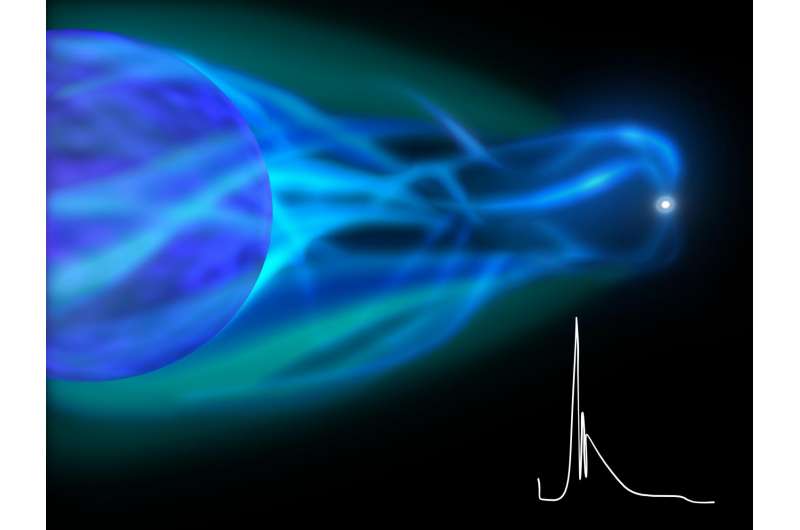Artist's impression of a Supergiant Fast X-ray Transient. The light curve at the bottom-right was retrieved by INTEGRAL from the supergiant fast X-ray transient source IGR J17544-2619 on Sept. 17, 2003. Credit: ESA.
(Phys.org)—A team of astronomers led by Enrico Bozzo of the University of Geneva, Switzerland, has recently studied a prototype of a supergiant fast x-ray transient (SFXT), designated IGR J17544-2619. The researchers investigated its spectral variability during outburst and quiescence, as this source exhibits one of the most extreme levels of X-ray variability among other objects in the same class. The findings were presented in a paper published Oct. 9 on arXiv.org.
Discovered in 2003 by ESA's International Gamma-Ray Astrophysics Laboratory (INTEGRAL) space observatory, IGR J17544-2619 has a quiescent X-ray luminosity and one of the shortest measured orbital periods among SFXTs – about 4.9 days. The source also showcases the most extreme X-ray variability among all other SFXTs.
In March 2015, Bozzo's team conducted a multi-wavelength observational campaign of IGR J17544-2619, using ESA's X-ray Multi-Mirror Mission (XMM–Newton) and NASA's Nuclear Spectroscopic Telescope Array (NuSTAR) spacecraft. By observing the source simultaneously with both space observatories, the scientists managed to catch it in an initial faint X-ray state and then while undergoing a bright X-ray outburst.
"We report on a 150 ks-long observational campaign performed in the direction of IGR J17544-2619 simultaneously with XMM–Newton and NuSTAR. During these observations, the source remained in a very low quiescent state for most of the time, and then, toward the end of the observations, it underwent a bright outburst comprising three distinct short flares lasting in total about 7 ks," the researchers wrote in the paper.
As was noted by the team, IGR J17544-2619 was initially caught by both telescopes during an extended quiescent period, which covered the first 33 hours and 20 minutes of observations. However, this state of quiescence did not deliver the expected crucial information on the nature of the source, as the statistics of the data were too low to carry out a time-resolved spectral analysis.
When a bright outburst abruptly interrupted the quiescent period, it enabled the team to obtain invaluable information about the activity of this source. The outburst happened at the end of the X-ray observations and lasted nearly two hours. This violent event consisted of three distinct fast flares, among which the first was the faintest one and the other two achieved a luminosity 1,600 times brighter than quiescence. The second flare allowed the scientists to observe significant spectral variability.
The researchers took advantage of the high statistics and good energy resolution of the instruments aboard the two space telescopes to investigate the properties of the source's X-ray emission during the quiescence and outburst periods.
"We studied the spectral variability during outburst and quiescence by using a thermal and bulk Comptonization model that is typically adopted to describe the X-ray spectral energy distribution of young pulsars in high mass X-ray binaries," the paper reads.
Complementary to the observations carried out with XMM–Newton and NuSTAR, the scientists also used the X-ray Telescope (XRT) aboard NASA's Swift Gamma-Ray Burst Mission to investigate IGR J17544-2619. Data from XRT showed that the source remained in a low emission state for most of the time. These results are consistent with the known property of all SFXTs being significantly sub-luminous compared to other supergiant X-ray binaries.
More information: Multi-wavelength observations of IGR J17544-2619 from quiescence to outburst, arXiv:1610.02648 [astro-ph.HE] arxiv.org/abs/1610.02648
Abstract
In this paper we report on a long multi-wavelength observational campaign of the supergiant fast X-ray transient prototype IGR J17544-2619. A 150 ks-long observation was carried out simultaneously with XMM-Newton and NuSTAR, catching the source in an initial faint X-ray state and then undergoing a bright X-ray outburst lasting about 7 ks. We studied the spectral variability during outburst and quiescence by using a thermal and bulk Comptonization model that is typically adopted to describe the X-ray spectral energy distribution of young pulsars in high mass X-ray binaries. Although the statistics of the collected X-ray data were relatively high we could neither confirm the presence of a cyclotron line in the broad-band spectrum of the source (0.5-40 keV), nor detect any of the previously reported tentative detection of the source spin period. The monitoring carried out with Swift/XRT during the same orbit of the system observed by XMM-Newton and NuSTAR revealed that the source remained in a low emission state for most of the time, in agreement with the known property of all supergiant fast X-ray transients being significantly sub-luminous compared to other supergiant X-ray binaries. Optical and infrared observations were carried out for a total of a few thousands of seconds during the quiescence state of the source detected by XMM-Newton and NuSTAR. The measured optical and infrared magnitudes were slightly lower than previous values reported in the literature, but compatible with the known micro-variability of supergiant stars. UV observations obtained with the UVOT telescope on-board Swift did not reveal significant changes in the magnitude of the source in this energy domain compared to previously reported values.
© 2016 Phys.org
























